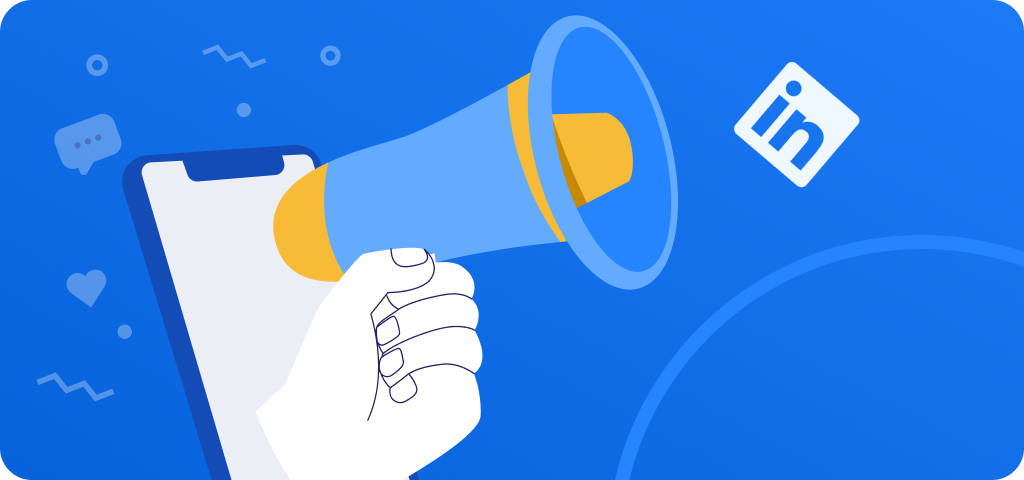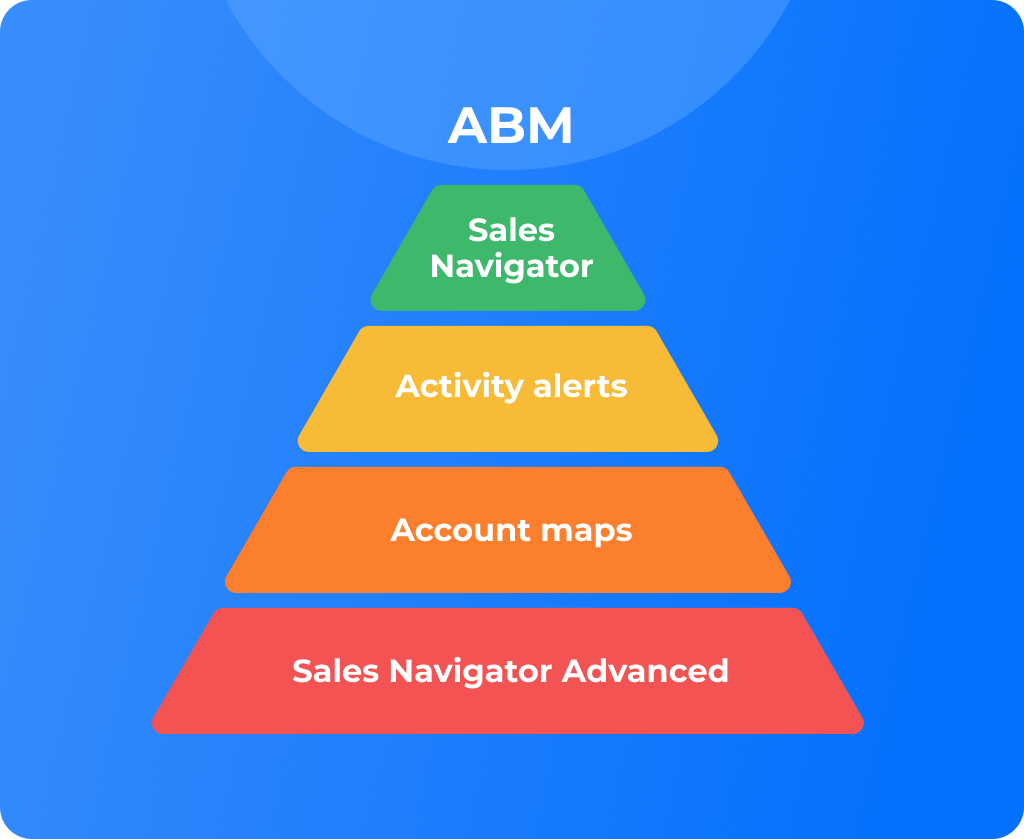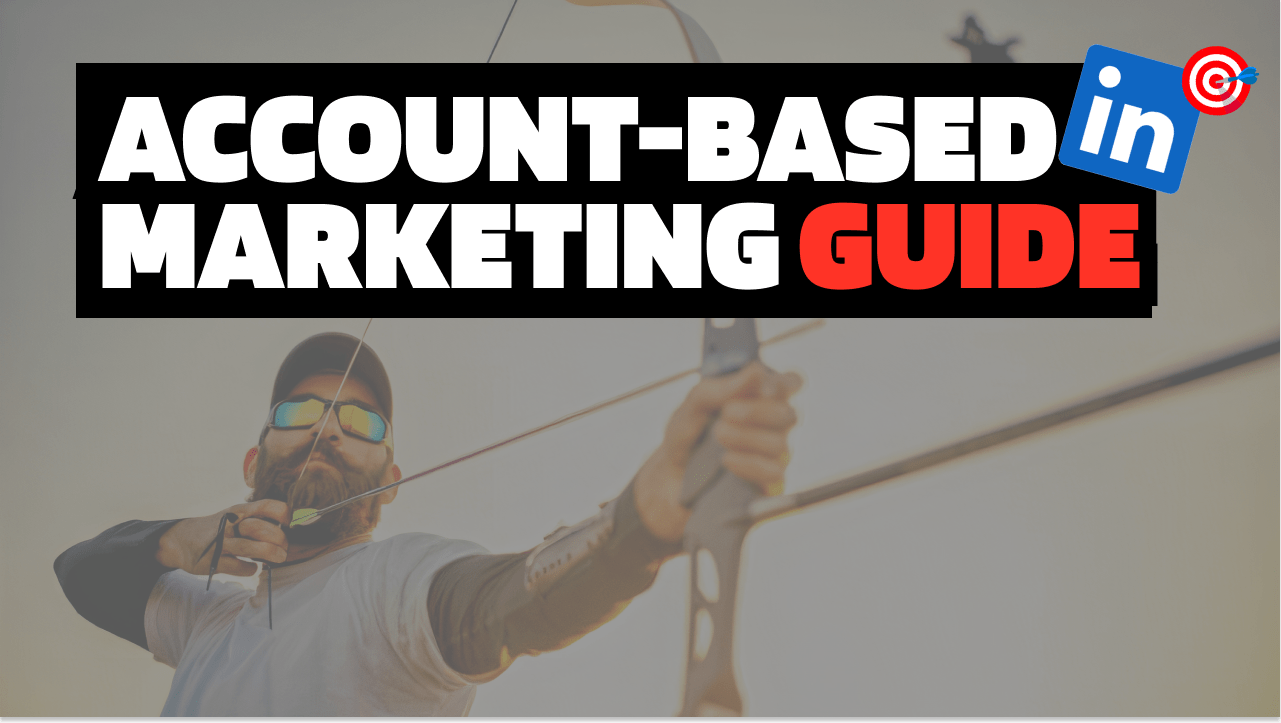Conversion rate isn’t the only important metric for successful sales outreach. As your lead generation improves, it pays to get strategic and approach companies with more precision using account based marketing on LinkedIn.
Landing a whale account can transform your organization’s legitimacy overnight. These top-priority deals give you vital social proof from well-known names and can lead to agreements larger than any other deal in your pipeline.
But you won’t catch such a whale with low-effort, copy-and-paste cold outreach. Instead, you need a more tailored approach that treats your ideal prospective company like it’s the only potential client that matters.
For these top-priority accounts, a new strategy is needed: LinkedIn account based marketing.
What is LinkedIn account based marketing?

Account based marketing, or ABM, is a prospecting strategy used to engage high-value, high-effort target accounts. Rather than casting a wide net and targeting many lower-value prospects, ABM counts on the tactical application of high-effort campaigns to 1 or 2 target accounts to create transformational results.
Sales and marketing departments work together to create tailored campaigns addressing laser-focused pain points. Then, key stakeholders are mapped out and added to highly personalized campaigns to create a sales conversation. Since these take time, LinkedIn ABM works best for your top 1-2 target accounts: the companies that, if you landed deals with them tomorrow, would significantly alter your bottom line.
If you’re already approaching a high volume of leads to make as many sales as possible, LinkedIn ABM is a great addition to your strategy. It ensures you put as much effort as possible into closing the accounts that would make the greatest difference to your business operations.
As you look to add account based marketing with LinkedIn, you can offload your other high-volume outreach campaigns to a Linkedin automation tool to free up more time for your highly strategic activities.
How does LinkedIn support ABM?
Account based marketing with LinkedIn makes strategic sense for a few reasons. Chief among these is that LinkedIn Sales Navigator was designed with several features that specifically support ABM campaigns.
- Sales Navigator allows users to create account lists and lead lists of ideal prospects.
- Activity alerts – sent for each saved lead or account – help with personalization and research.
- Account maps visualize the links and hierarchies between saved leads at a target company. These are vital for finding a way into an account.
- With Sales Navigator Advanced, teammates can make warm introductions to prospects they already know on behalf of colleagues – again helping with account engagement and adding a personal touch.

Account based marketing relies on sales and marketing working together to get results. LinkedIn is great for this as both departments regularly use the platform – marketing for advertisements, and sales to generate leads using Sales Navigator. Adopting account based marketing with LinkedIn ensures both teams operate in alignment to secure top-priority sales deals. Not only is this a better way to generate results, but it can increase collaboration between the departments more generally. This only means good things for your bottom line.
Below, we’ll cover step-by-step instructions to get started with ABM on LinkedIn.
How to do account-based marketing on LinkedIn
For LinkedIn ABM, your sales team will need Sales Navigator licenses. It’s also a good idea for marketing to have a Campaign Manager account to run LinkedIn ad campaigns, if your budget supports them.

1. Decide your target accounts
Before you begin a LinkedIn account based marketing campaign, you need to identify the prospective companies that would make the most difference to your bottom line.
Generally, you’ll want to find prospective companies with healthy funding or revenue, that have the incentive to buy your most lucrative products, features, or packages.
The best way to find these businesses is by looking at your ICP. Consider your ideal customer and your history of customers to date. What characteristics make a company more likely to need your most profitable packages?
How to find target accounts
Once you have an idea of the company profile you’re looking for, you can use a tool like Crunchbase to search and filter companies that have recently gone through large funding rounds.
You can also use Sales Navigator to discover the companies in your niche that are growing the fastest and meet your ICP criteria. You can narrow your Sales Navigator search to companies or departments with growing headcounts, those with revenue over a specific amount, or those with a certain number of employees.
For example, if you suspected Enterprise accounts would have the best returns, you could filter for companies with 1K+ people. But if you were worried organizations that large and established could have too much red tape, you could focus on fast-growing scale-ups and filter for companies with 250-1K people with growing headcounts.
Other LinkedIn signals can also help you determine which accounts from these search results most deserve your initial focus. Once you save your target accounts into an Account list on LinkedIn Sales Navigator, you will get notifications and updates on company news, either via email or in your account sidebar. These can help you decide which companies to target first.
If you already have a list of prospective accounts, determining your LinkedIn ABM focus is easier. Simply look at the highest-value accounts on your existing lead list. These are the ones that would bring you the most revenue at the best margin if they purchased your product or subscription service.
2. Add leads for each account
Once you’ve found your ABM target accounts, save them to a dedicated Sales Navigator account list. Doing so lets you track all activity across the company and move on to the next step: establishing lists of leads for each account.
When you start saving leads to an account, Sales Navigator will add them to a lead list and an account map. This visual representation of your target organization’s hierarchy will help you determine the best way into the account.
How to find the right leads
For each ABM account, you’re looking for around 11 key stakeholders. This is the number of decision-makers typically involved in the B2B buying cycle. LinkedIn automatically sorts saved leads into Tier 1, 2, or 3 based on their perceived seniority level. The platform also maps out which leads likely report to which others.
This chain of command can give you a path into the account. By reaching out to junior employees first (tier 3 contacts), you’re more likely to get a response. Then, you can use any insights from these individuals to attract the attention of more senior stakeholders.
For example, you could ask junior leads to confirm that your target tier 2 lead is responsible for the area of the business your product improves. If you’re not focussing on the right person, you can ask to be redirected to the appropriate stakeholder.
To find the right leads to target within each ABM account, use your marketing department’s ICP research as a starting point. Using Sales Navigator, you can search the target account’s list of employees on LinkedIn for individuals with specific titles or seniority levels.
For example, if you’re selling a piece of sales software, you might want to look for a ‘Head of Sales’, a ‘CCO’, and a few ‘SDR team leads’ or ‘Senior AEs’ at a larger company. At a smaller start-up, you might add any employees within the sales department, plus the CEO.
Using Sales Navigator, you can share these account maps with other members of your sales and marketing departments.
3. Plan your approach
Successful Linkedin ABM relies on sales and marketing working together. It’s not a quick fix: it requires steady planning.
If you’ve shared your account map with colleagues and you have a Sales Navigator Advanced plan, you can use TeamLink to see if anyone at your company has warm routes into your target accounts. Even if you only have the basic version of Sales Navigator, LinkedIn will highlight any second-degree or shared connections.
Now is the time to begin researching your target decision-makers to understand their likely pain points and personalize any outreach. As you learn more about your target organization, you can begin to update LinkedIn’s default account map to increase its accuracy.
Now you know more about your prospects, you can begin to put a streamlined sales and marketing LinkedIn ABM plan into action.
4. Add marketing support
Marketing should use LinkedIn’s Account Targeting feature to run targeted ad campaigns to key accounts in the weeks before sales’ Linkedin outreach begins. This will familiarize the key stakeholders with your company and product.
This stage is also when other larger-commitment assets can be planned, such as tailored sales letters or video outreach. As these are your top-tier personalized accounts, you can afford to get creative and expend extra effort. Brainstorm all your off-the-cuff ideas – when it comes to standing out and reaching those transformational accounts, lateral thinking wins the day.
5. Begin sales outreach
Once Linkedin ads have been running for a week or two, it’s time for sales reps to begin targeted outreach. Generally, this works best if one sales rep takes the lead on each key target account. However, if you have a really large or important target ABM account, you could use a small team, such as a Senior AE with a supporting SDR.
At this stage, it’s important to track your outreach progress using a CRM or LinkedIn automation tool. This ensures alignment across teams and departments. Strong coordination between sales and marketing can make all the difference in getting results.
For example, if leads start to engage, marketing can double down on ads to nudge key stakeholders toward a positive decision. If leads go cold, they can use adverts to re-target them and keep your offering top of mind.
Linkedin ABM is a medium-term strategy – you probably won’t see results overnight – so continued alignment and persistence is crucial.
6. Nurture engaged leads
Once you start to get results from your outreach activities, the attention doesn’t stop. The key aim with these highest-value accounts is to make them feel important and attended to. That’s why your sales and marketing strategy should include some customized offers to tempt leads that begin to engage.
Some examples of value-adds you could offer include bespoke webinars and events or access to usually gated industry insights.
Your aim is to go above and beyond in every interaction with these ABM prospects. As they start to engage with your company, pull out all the stops to develop connections and progress them through the lead funnel.
Don’t just stop at marketing, either. Consider how your senior stakeholders and C-suite can get involved in outreach or meetings to make these leads feel extra special.
7. Iterate and improve
Linkedin ABM campaigns generally take at least two months and can take up to two quarters. That’s why they’re reserved for your very top accounts. It’s also why it’s crucial to do higher-volume automated outreach campaigns alongside them.
After a couple of months, you can evaluate your results to determine whether your efforts have been successful. Ideally, you’ll have nabbed an account that’s transformed your organization’s legitimacy and made a healthy difference to your bottom line. But even if you haven’t, you can use the insights from your efforts to iterate and improve your process.
Account based marketing on LinkedIn can take time to get right and produce results. Any engagement statistics or learnings from discovery calls can be carried forward into your next ABM campaign.
Advanced LinkedIn account based marketing tips

That’s the general structure of ABM on LinkedIn sorted. But if you’re ready to take your LinkedIn lead generation to the next level, you should consider how your ABM strategy fits in with your broader LinkedIn outreach.
True ABM requires significant sales, marketing, and executive input. It’s incredibly effective, but can only be done for a couple of accounts per quarter. To consistently hit sales targets, you need ways to streamline your other outreach efforts.
One way of doing so is to split the rest of your target accounts into medium- and lower-priority categories. Lower priority accounts can be added to large, untailored automatic outreach campaigns. These require little upfront effort and no ongoing demands on your time. Simply set up your automated LinkedIn cadence, add your contacts, and benefit from LinkedIn lead generation in the background.
Some of the techniques and tips from your ABM campaigns can improve your LinkedIn outreach to medium-priority accounts. By personalizing your opening hooks for these cadences, you can benefit from better conversion rates while still using automation. A tool like Salesflow can help you optimize your outreach and improve your efficiency. Try us out for free with a 7-day trial:
